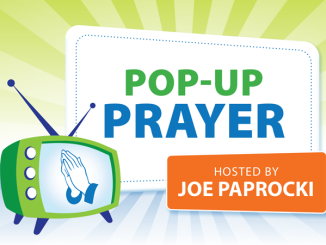For many Catholics, the thought of being called upon to lead a spontaneous prayer can darn near bring on a panic attack! Never fear! Our Judeo-Christian heritage provides us with a simple formula to follow that will guide you in organizing your thoughts into a cohesive, intelligent, and heart-felt spontaneous prayer.
First, take a look at his prayer offered by King Solomon (2Chronicles 6:14-17). At first, it looks like a lot of words, however, we’re going to see that there are really only 3 things going on here (see the color coding). This Jewish form of prayer called Berakhah (behr-ah-KAH) follows a simple 3 step formula.
“Lord, the God of Israel, there is no God like you in heaven or on earth—you who keep your covenant of love with your servants who continue wholeheartedly in your way. You have kept your promise to your servant David my father; with your mouth you have promised and with your hand you have fulfilled it—as it is today. And now, Lord, the God of Israel, let your word that you promised your servant David come true.”
Now, before we identify this 3-step formula, take a look at another example which comes from the Liturgy. You’ve heard these words countless times before but now look at them with the color-coding. You’ll recognize that this prayer of the Mass follows the Berakhah formula.
Blessed are you, Lord God of all creation, for through your goodness we have received the bread we offer you: fruit of the earth and work of human hands, it will be become for us the bread of life.
Here’s what’s going on in a Berakhah prayer.
First, we name and bless/praise/thank God. – We name God in many ways: “Heavenly Father…” “Good and gracious God…” “Loving Father…” “Almighty and all-powerful God…” What are some other ways you can think of “naming” God?
After we name God, we can bless, praise, or thank God in a number of ways: “Blessed are you…” “Our hearts are filled with gratitude this day…” “We bless and praise you…” “Thank you for…” What are some other ways you can think of to bless, praise, thank God?
Second, we gratefully remember the wonderful things God has done for us – both long ago and up to the present. – We recall the amazing things that God has done – long ago: “You created this wonderful world for us to live in…” “You saved your people from slavery in Egypt…” “You made a covenant with Abraham…” “You sent your only Son Jesus…” or recent/up to the present: “You have blessed this school with…” “You have called us to this wonderful ministry…” “You have brought us here together for…” What are some other things God has done that we can gratefully remember?
Third, we ask God for something – we petition God. – Now that we have named and blessed God and recalled his wonderful deeds, we ask for one thing more, usually pertaining to the purpose of the gathering: “We ask you to open our minds and hearts as we…” “Bless this assembly…” “Help us to become more…” Imagine yourself called upon to lead prayer for a group/at an event: what is one thing you would ask God to do for this group/event?
Just put those 3 ingredients together and speak to God as one friend speaks to another and voila, you are saying a spontaneous prayer! Be sure to conclude by making the prayer through Christ our Lord or in Jesus’ name and wrap it in the Sign of the Cross at beginning and end!
Here is a PDF of the above that you can use as a convenient handout!




I like this.
Coming through RCIA from a Protestant evangelical church, I was so surprised that Catholic middle school kids don’t know how to pray aloud spontaneously. Yet I didn’t know where to begin explaining how to–and I especially didn’t know how such prayers fit with Catholic Tradition. This is wonderfully helpful!
Helpful and simple. I feel encouraged to develop this style of prayer. Thanks.
You’re very welcome!
This is such an educative post. A boost to my confidence and prayer skills. And Most importantly,may the Lord answer all our prayers.
Thank you Mr. Paprocki. I am used to praying my Catholic prayers daily, but spontaneous group prayer is new to me. This simple formula will give me confidence to pray when attending faith based groups & evangelization groups. God bless!
You’re welcome, Sheila…leading spontaneous prayer is often “foreign” to many of us Catholics!
Mr Joe, you’ve made my life so easy by sharing this format. A prayer for you everyday for encouraging one more catholic to do spontaneous prayer. Thank you so much. God bless you always.
Thank you, Victor, for your kind words! Glad you found this helpful!